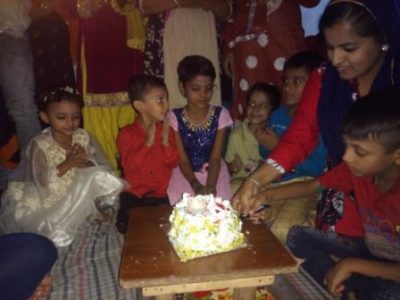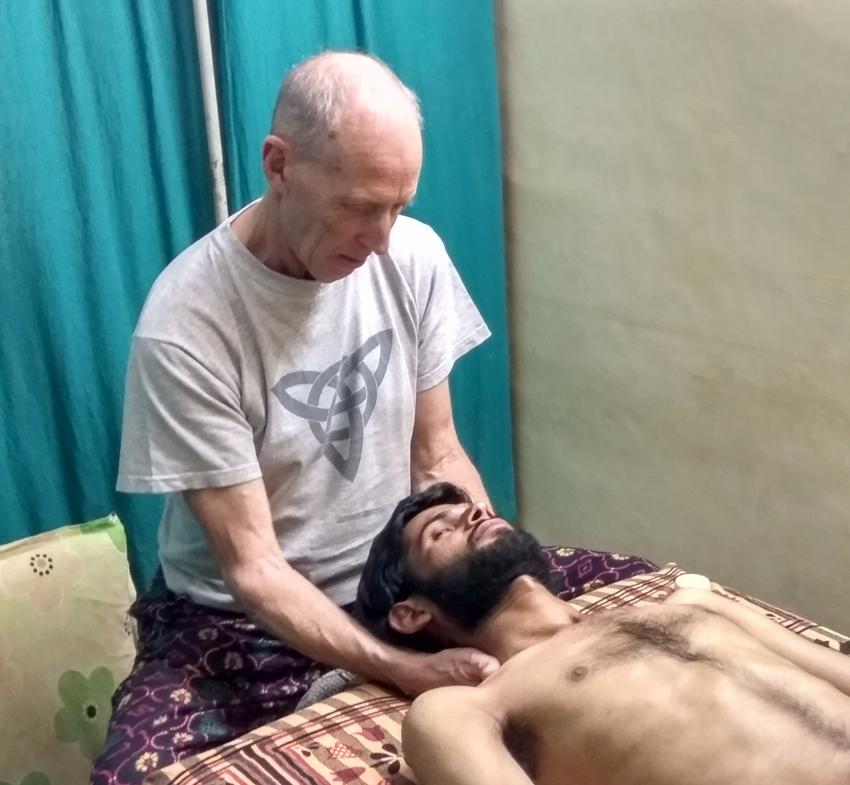
Ian Jarvis is a practitioner and tutor of ‘Spineworks’, a form of physical therapy focusing on the soft tissue of the body. Spineworks is a holistic form of spinal therapy which understands the spine in terms of it being just one part of a complex, tension structure of bones and ligaments, as opposed to it being a simple column of bones in compression. This gives rise to a different understanding of underlying problems, along with a different set of options to help put them right.
Ian is currently in Bhopal, for the fifth time, voluntarily offering his services at the Sambhavna clinic. Ian has been keeping a diary, recording some of his experiences of life in Bhopal and you can find a round-up of October’s and November’s events here.
Ian has also been recording a video diary. These lovely videos can be found on Ian’s Facebook page BhopalToday, or on the BMA’s Facebook page. Please take a look for a real sense of the flavour of Bhopal.
Saturday 1st December
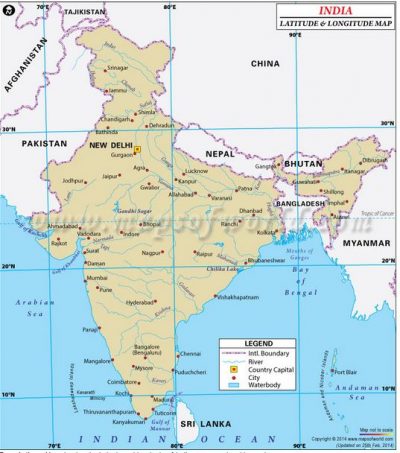
Where is Bhopal? Some of you reading this may not know exactly where Bhopal is. You can see it on the picture centrally located in the widest part of the country which makes it a good location for one of the biggest railway junctions in India. It’s a pity though that the airport is not an international one which means we have to fly via Mumbai or Delhi (usually) and then travel by domestic flight or train to Bhopal.
You might notice that it is just south of the tropic of Cancer which you cross over if you make a day trip to Sanchi, a historic Buddhist site. Geographically it is approximately 23°N and 77°E.
It is also known as “the city of lakes” for obvious reasons; there are lots of lakes, all of which are artificial. Most people visit the big one, created in the 11/12th century I think I recall. Most enjoyable for me is to start at Kamla Park which is on the dam dividing the ‘upper lake’ from the ‘lower lake’. It is a lovely, small park with a couple of interesting buildings and on the lower lake side, more gardens and a nursery. Then to cross the road and walk along the shore path to reach, eventually, the boat jetty. Here there are boats and pedallos for hire and you can make a trip to an island mausoleum. After that it is by now almost tradition with volunteers to walk up to Wind and Waves for refreshment, food and sunset. Definitely an auto-rickshaw back.
Despite not being a tourist destination, it does have some interesting features. It used to be a ‘rest and recreation’ centre for troops in the British occupation and there are many buildings redolent of that era. My favourite place is Bharat Bhavan, an art and theatre venue and I have attended many music and dance concerts there and enjoyed looking at the art on display. Just past the boat jetty is a large museum with both outdoor and indoor displays. There are many hotels also, from cheap and cheerful to atrociously expensive. The latter is the only place you can have a swim!
The Problem of Illiteracy: One thing that we just don’t think about in the ‘developed countries’ (so called!) is illiteracy. It is easy to send out a universal message on a flyer or leaflet. Here that is not a possibility. The radio and TV are also not possible for the campaigns here.
This is why I see many pictures around the clinic in addition to words on notices. I recall some years ago when ICJB* were organising a ‘lie-down’ on the railway, which had to be carefully planned and executed since we wanted no-one to be run over by a train though arrest or violence by the police was a strong possibility.
As luck would have it a photographer was visiting at the time and, although Nicholas was focusing on Chingari, he was borrowed by Sathyu to help create a pictorial set of guidelines which was taken around the neighbourhoods and proved to be highly successful. As did the railway demonstration, by the way.
So here are a couple of notices just outside the observation room where I work.
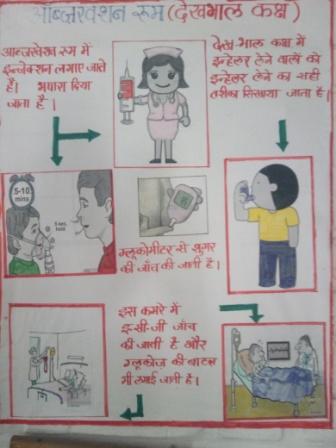
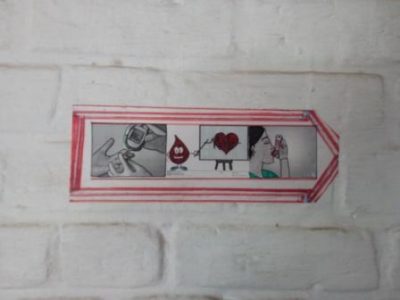
Chingari: During the month I planned to begin working at the Chingari clinic for two days a week. This clinic, also supported by the BMA, is a sister to Sambhavna. It was created in 2004 to give education, treatments and support to children with disabilities and their families. These are children born to couples who were affected by the gas or water and now they are well into the third generation with the rate increasing; currently 10 times worse than the average in the rest of India.
It was lovely to return there after several years and to be recognised by many of the staff and children. Sometimes this is what makes it all real and, in particular one young man, Umar, whom I had treated before when I volunteered here. I asked about his brother who I treated alongside him – they both ‘had’ muscular dystrophy, and I was told he had died. This was to be expected since this illness leads to a much reduced life-span. Rohit, a photographer journalist was visiting at the time for a few days and later in the week he and I went to Umar’s home to take some pictures. Azhar, “died on 22 December last year”, he was 31 years old and had been taken to the hospital for the last two days of his short life. Ayyud, his father showed us some pictures of him shortly before his death. He was the young man I remembered.
Umar is now fully aware of the fate that is just around the corner for him. His general health is better than his brother’s was so he may live a little longer, but he is now 24.
As it happened, I decided against sharing my time between both places. My workload at Sambhavna has been increasing with new patients almost daily and I can be working from 08:30 until 16:00 some days with barely 15 minutes for lunch. It is also hard to get people to understand that they don’t attend every day – even when many don’t in reality! I did make another of my interview videos though, with the three physiotherapists, Sanjay, Huma and Rishi, which you can see on the Bhopal Today page on Facebook. (This is a regular weekly feature.)
Weight problems: I see many overweight people on my table. I always advise about weight loss and sometimes refer them to Shweta, the yoga teacher and a Naturopathic Doctor, who has a responsibility for advising on diet. With the standard diet among many people here, not just the poor members of society, losing weight can be a challenge and, mentally, few are prepared to engage with it.
At least twice a day, the meal will be chapatti and rice with a daal and a small dish of vegetable. The rice and chapatti are the ‘filling’ foods and many people will eat 5 chapatti in one meal. Often breakfast is also rice based of some form of paratha (i.e. a thick version of chapatti!).
This makes a lot of carbohydrate in a day. Not surprising then that there is also a high incidence of diabetes.
Whenever I mention to someone that they need to lose weight if they want their back or knees (for example) to heal they smile and turn away.
Diwali: This year Diwali began on 7 November. Like the Christian Easter it is a “moveable feast” which means that the date each year is dependent upon the cycles of sun and moon. The festival lasts for 11 days. After Diwalli comes the marriage season in full swing. It is not the only time people get married of course but is a popular time.
Diwali is also known as the “Festival of Light” and many people will decorate their homes inside and out with candles, oil lamps and electric lights. In my UK birth city of Leicester, once the communal city lights go up for Diwali they stay up until after Christmas.
Diwali symbolises the spiritual “victory of light over darkness, good over evil and knowledge over ignorance”. It is probably the most popular festival in India, essentially Hindu but some other faiths also celebrate their respective festivals alongside it. The Jains observe their own Diwali, the Sikhs celebrate Bandi Chhor Divas, while Newar Buddhists, unlike other Buddhists, celebrate Diwali by worshiping Lakshmi. I asked Shabnam what she would do as she is a Moslem, if they did not celebrate it, “well”, she replied “a festival is a festival!” I think that is the attitude of most Indians.
There is one day of public holiday on which I went to eat with Beena who is one of the two Panchakarma therapists for women and who lives right opposite the gate to Sambhavna on the top floor with a great view far over Bhopal from her rooftop.
The next day I left Sambhavna with Ratna and dined with her family, many of whom attend the English coaching class I mentioned in my report last month.
Jain: AND, writing about Jain reminds me that we went to a Jain temple near the New Market area. We were invited one Sunday to visit the temple. Jain priests renounce everything and wander India naked with a brush with which they sweep the ground in front of them so they don’t inadvertently kill anything.
Jay’s family was also with us, (Dr) Roopa and the two children Meghnan and Manos and we were given a guided tour around. Aashi, daughter of Jay’s friend in the sect, became my personal guide for the next few hours. I met three priests and the picture is with one where I was ushered into that position! They also provide a good lunch for everyone.
I did wonder what the reaction in the UK would be to a naked man wandering from temple to temple, brushing the ground before him.
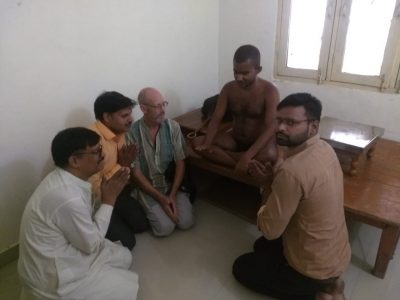
Friday, 02 November 2018
I have been at Sambhavna now for nearly 3 weeks on this, my fifth visit. It’s a good time of year for a British visitor as the weather is slowly cooling. For the first couple of weeks it was unusually hot, but now it is like very warm UK summer days and at night I don’t even need the fan.
My last visit was early in 2017, and since then there have been a couple of weddings for friends of mine – friends I have made through contacts at Sambhavna though neither works here. Amir was the first, late in 2017, he is a player of the sarod, and then Yasir earlier this year, who is an IT specialist. Both arranged marriages. Unfortunately I could attend neither wedding. However I was able to attend the ceremony of Devendra’s wedding the first week I arrived and did a video of the ceremony for them. Unusually for India, it was a very small affair with about 10 of us present and later in the evening about the same number at dinner. I have, of course met Deven’s wife and a couple of nights ago had dinner at Yasir’s home and, briefly, met his wife.
There have been several staff changes since my previous visit but still the majority remain. Many of the staff have been personally affected, either themselves or members of their families so they have a particular dedication to the clinic and the work.
There is a new (allopathic) doctor, Dr Usha, who is a cardiology specialist and also a new gynaecologist, Sonali. Shabnam and Aziza, the nurses and my trusty interpreters have been joined part-time by Prabha who also works as a staff nurse at the Hamidia Hospital. All but Raj of the guards (or Guardians) are new and there are sundry other people not all of whom I have met. The café (or canteen) is now run by Pushpah, who I got to know some years ago as the wife of one of my patients, and her very able daughter-in-law, Madhu.
I have renewed my friendly and interesting relationship with Diwaker who is responsible for the maintenance among other things. I always tell him about problems! He has said in the past that he’s generally grateful since he then knows about them and can fix them. So already he has had the hot water pipes from the solar collector cleaned of lime so now we have a flow of warm water. We hope that a pump will be added so that a hot shower is possible.
I plan to make a series of video interviews of some of the staff members (probably only the English speakers) and put them on my special Bhopal Facebook page – “Bhopal Today”. Pop over and ‘like’ or ‘follow’ the page and please share the videos as widely as you can simply to spread the word. Somewhere there is rich person who will be moved and inspired!
As an aside, there has been a fall in the general level of donations and this IS having an affect on the clinic in practical ways.
The first and current interview video though, was with two young volunteers who I met on my arrival here. Emma and Aileen qualified as physiotherapists earlier this year and wanted to come here before looking for jobs. In their university they had heard a talk by Tabish, who works at Chingari, the sister clinic, and had been inspired to want their first experience as unsupervised professionals to be here. Although they were working in Chingari they were staying at Sambhavna, since Chingari has no accommodation. They have now gone on their way so temporarily, I am alone.
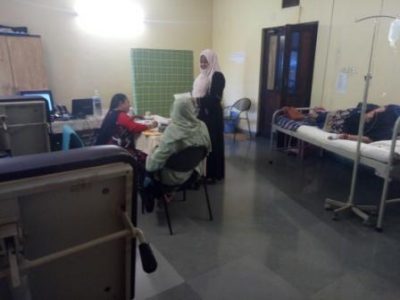
As is now becoming frequent if not regular, I have set up my table in the Observation Room where the nurses work. Shabnam, knew that I was coming this autumn but I had not written and told her when, so as I walked into the room she jumped up with surprise and gave me a big welcome hug, probably to the surprise of Prabha! Sometimes, if you don’t know a person, a hug is not quite the thing in India but age and familiarity are good signals it’s OK. By the time I was next in the room she and Prabha had moved the beds etc around so that I could put up my table.
When I first arrive I can be busy socially with several invites. Invitations to visit to homes are usually made by women and when you are a lone male that means that you will get few if any. If there are female volunteers also, then you may be invited along with them. With the ones who know me now though it seems fine to go as I am.
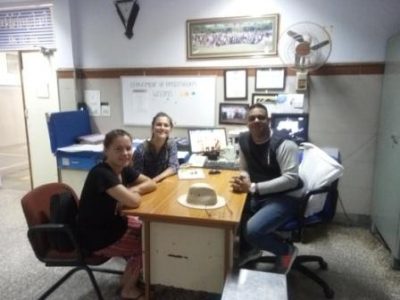
In conversation with Emma and Aileen I asked if they would like to see the inside of a hospital. I have met Aslam who runs the physio department at the Memorial Hospital and we keep in touch on an infrequent basis. I contacted him and he said we could visit anytime so they were able to see what physio is like, although the Memorial Hospital is the best of any that I have been in during my trips here and may not be typical. Aslam also showed us into one of the wards which was interesting – there was little concession to privacy and I noticed that several people had brought in food. I think that is not included in the hospital fees. This hospital, which is situated on the northern edge of the city and not entirely convenient to reach, was built with money given by Union Carbide.
Editors note: Although the BMHRC (Bhopal Memorial Hospital and Research Centre) technically may have been built with Union Carbide money it can hardly be seen as an act of benevolence. In October 1991 the Supreme Court ordered Carbide to construct a 500-bed hospital to meet the medical needs of the gas victims. The construction cost of the hospital and its running cost for eight years, which was estimated to be around £5million at that time, was to be borne by UCC and UCIL. The Bhopal Hospital trust raised its money by selling Union Carbide’s shares in Union Carbide India Limited which were in fact subject to an attachment order and, thus, effectively worthless to Carbide. See: 14-15 February 1989 – December 1993 for further detail.
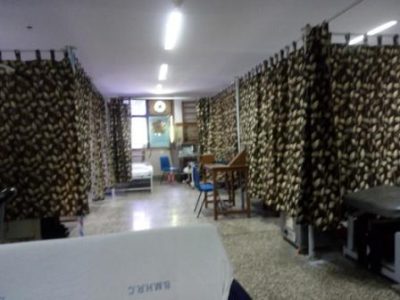
My first social lunch was one Sunday with Mahendra who heads the pathology department. Her youngest son, Aradhya, asked me if I would visit his English coaching class but that Sunday I was a little tired and said “not today, but I will”. This resulted in Ratna collecting me one afternoon as we closed and bundle me into front of an auto-rickshaw where she sat in the back with Mahendra (her sister) and Asha (one of the new cleaners). Ratna is the head gardener and Mahendra’s sister. I thought this was for dinner, but when we arrived at the house where she lives, next door to Mahendra, she took me out and after some minutes I found myself standing in front of a varied class of over 20 students in the English coaching class. One of the mantras of The Professional Speaking Association is always to be ready to give a presentation without warning. Here was my chance. For over three hours I had a conversation with the class and was immediately invited to return.
The next time, two days later, I was prepared and did an exercise that involved them doing most of the talking. There was much enthusiasm and excitement and of course some nervousness at speaking to the whole class but they all said they had enjoyed it. I am booked again! Now I just need to invent some more exercises for a fairly mixed range of ages and abilities. My impression, from some experience as well as observation and conjecture, is that much teaching is “old fashioned” and tends to stick with old formulas without much innovation. My session was all imagination and no experience!
In conclusion this time, please do go and check out “Bhopal Today” and watch the interview with Emma and Aileen. Share it around and mention that donations are reduced at the moment, the money goes much further here but they still need a regular supply.
